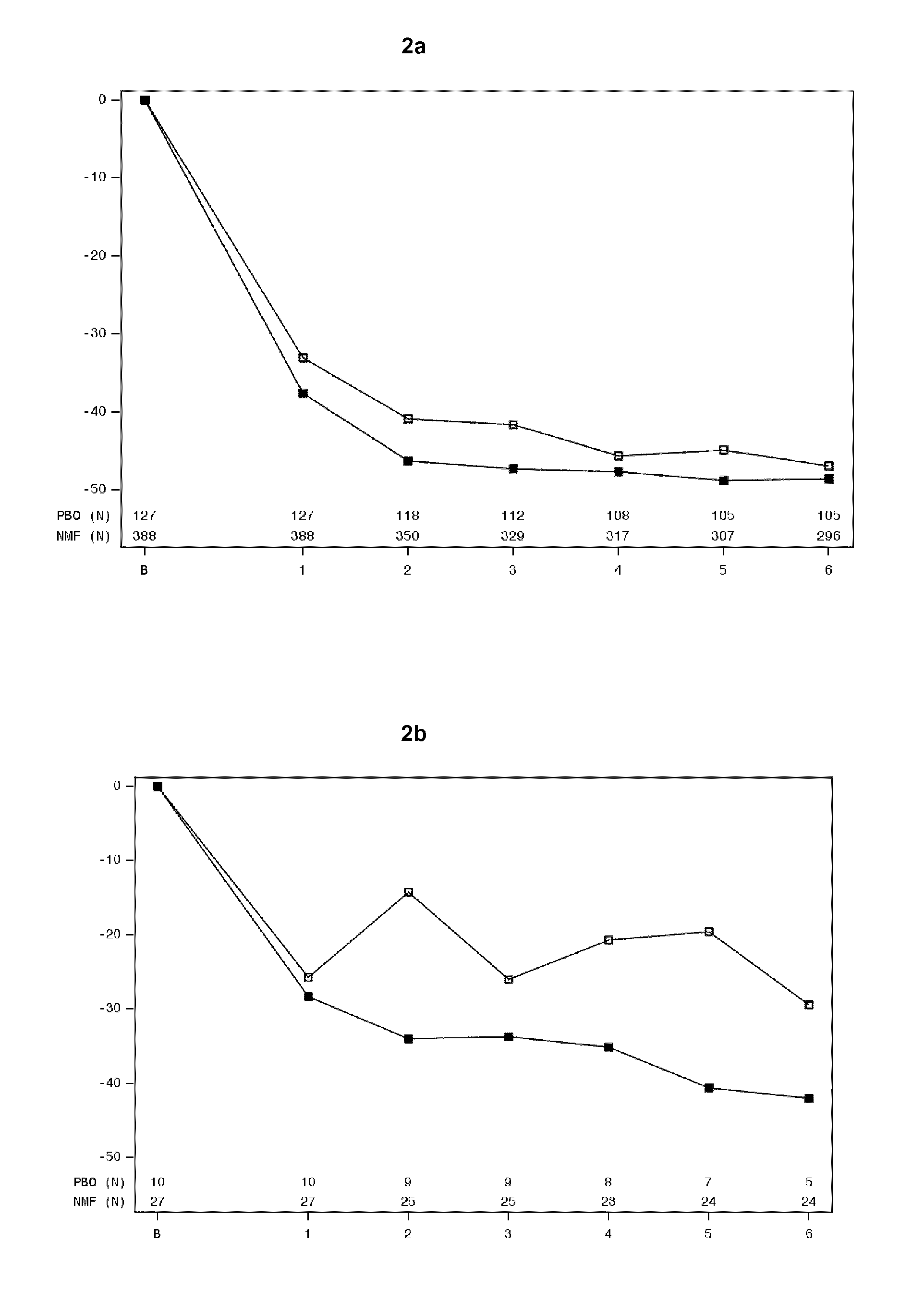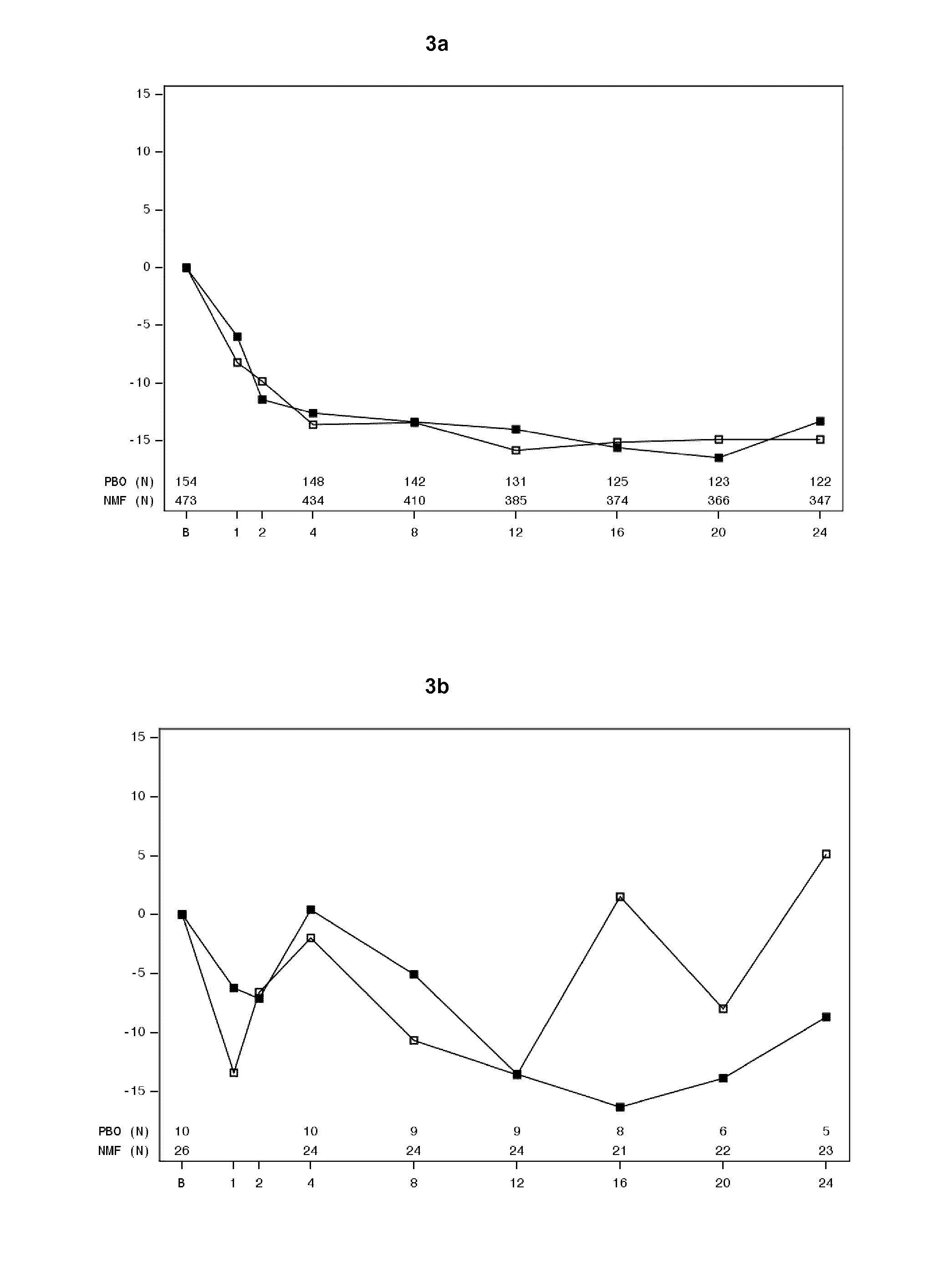Nalmefene for Treatment of Patients with Mood Disorder
a technology for mood disorders and nalmefene, which is applied in the field of nalmefene for the treatment of patients with mood disorders, can solve the problems of increased risk of comorbid mood disorders increased risk of alcohol dependence in patients with depression, and high level of lifetime comorbidity between depressive and anxiety disorders, so as to reduce alcohol consumption and reduce alcohol consumption
- Summary
- Abstract
- Description
- Claims
- Application Information
AI Technical Summary
Benefits of technology
Problems solved by technology
Method used
Image
Examples
example 1
Clinical Efficacy on the Reduction of Alcohol Consumption
[0180]The efficacy of nalmefene on the reduction of alcohol consumption in patients with alcohol dependence (DSM-IV) was evaluated in a multi-national, multi-site, randomised, double blind, two parallel group, placebo controlled 1 year safety study (Study 12013A). The efficacy was evaluated over 24 weeks of treatment. The study included outpatients, aged ≧18 years, with a primary diagnosis of alcohol dependence. A patient was eligible for participation in the study if, in the 4 weeks preceding the Screening Visit, he / she had: ≧6 HDDs, ≦14 consecutive abstinent days, did not have serum aspartate aminotransferase (ASAT) and / or serum alanine aminotransferase (ALAT) values >3 times upper limit of the reference range, that are in the investigator's opinion clinically significant. Patients with psychiatric co-morbidity (that is, patients who used stable doses of antipsychotics and / or certain antidepressants) were also included unles...
example 2
Clinical Efficacy Measured by POMS Score
[0183]Assessment of POMs scores in Study 12013A was used to evaluate the effect of nalmefene on mood states and mood changes throughout the study. The change in POMS scores from baseline are illustrated in FIGS. 3-9. FIGS. 3a-9a indicates that in patients without a mood disorder at baseline, the pattern in POMS score was stabile throughout the study with no pronounced difference between nalmefene and placebo.
[0184]Tables 7 and 9 indicate that patients with a mood disorder at baseline had higher POMS scores at baseline when compared to those without a mood disorder. FIGS. 3b-9b indicates that the patients with a mood disorder at baseline who received nalmefene had a better POMS score at the end of the study than the patients with a mood disorder at baseline who received placebo. In particular FIGS. 3b, 4b, 5b, 6b and 9b representing total mood disturbance, tension-anxiety, depression-rejection, anger-hostility and confusion, respectively, indic...
example 3
Alcohol Consumption and POMS TMD in Patients Selected by MINI Inverviews
[0187]Table 10 below outlines drinking variables and POMS TMD score patients from the 12013A study with a mood disorder at baseline who were classified based on MINI standardized interviews.
TABLE 10Drinking variables and POMS TMD score in patients with a mooddisorder at baseline according to MINI assessment.NalmefenePlaceboN2213HDDBaseline16.020.51 year6.013.8TACBaseline80.3106.11 year20.851.1POMSBaseline68601 year3741
Non-Clinical Assessment.
[0188]Further characterization of nalmefene for the treatment of mood disorders can be assessed in non-clinical models e.g. models for assessment of acute effect as outlined in Examples 4-6 and / or models for assessment of chonic effect like the chronic mild stress model described in Example 7. Nalmefene can be assessed in each model both as the sole active substance as well as in combination with a second compound.
[0189]Nalmefene can be administered e.g. in the form of nalme...
PUM
| Property | Measurement | Unit |
|---|---|---|
| time | aaaaa | aaaaa |
| mood disorder | aaaaa | aaaaa |
| lifetime comorbidity | aaaaa | aaaaa |
Abstract
Description
Claims
Application Information
 Login to View More
Login to View More - R&D Engineer
- R&D Manager
- IP Professional
- Industry Leading Data Capabilities
- Powerful AI technology
- Patent DNA Extraction
Browse by: Latest US Patents, China's latest patents, Technical Efficacy Thesaurus, Application Domain, Technology Topic, Popular Technical Reports.
© 2024 PatSnap. All rights reserved.Legal|Privacy policy|Modern Slavery Act Transparency Statement|Sitemap|About US| Contact US: help@patsnap.com










